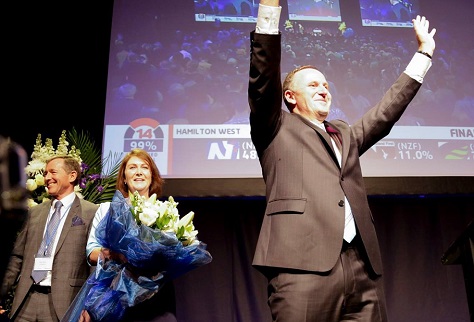New Zealand’s voters didn’t have a chance to vote on a new flag during Saturday’s general elections, but they emphatically delivered prime minister John Key a third term in government.![]()
Key (pictured above) led the center-right National Party to a majority government, winning 61 seats in the country’s unicameral, 121-member House of Representatives, the first such majority government since 1993, when the country still used a first-past-the-post voting system. New Zealand today uses instead a mixed-member proportional representation system.
 Though the campaign featured more political scandal and innuendo about surveillance than policy discussion, Key has in two terms amassed a considerably solid record. In his first term, he helped to steady New Zealand’s economy in the depths of the global financial crisis, and he’s maintained generally solid GDP growth — around 2.5% in 2013 — in the face of a Chinese economic slowdown.
Though the campaign featured more political scandal and innuendo about surveillance than policy discussion, Key has in two terms amassed a considerably solid record. In his first term, he helped to steady New Zealand’s economy in the depths of the global financial crisis, and he’s maintained generally solid GDP growth — around 2.5% in 2013 — in the face of a Chinese economic slowdown.
In that time, Key raised the goods and sales tax from 12.5% to 15%, but he also lowered personal income tax rates and increased the minimum wage from NZ$ 12 to NZ$ 14.25. In his second term, Key initiated a program of privatization of several government interests by reducing public ownership in several companies, including Air New Zealand and several energy enterprises. Key also managed the reconstruction efforts of Christchurch, New Zealand’s second-most populous city, which was severely damaged by a 2011 earthquake.
He has also been keen on developing stronger ties with the United States as a champion of the Trans-Pacific Partnership trade pact and of the 2010 Wellington Declaration, which ushered in greater cooperation between the United States and New Zealand.
Continue reading Key leads National Party to easy reelection in New Zealand
